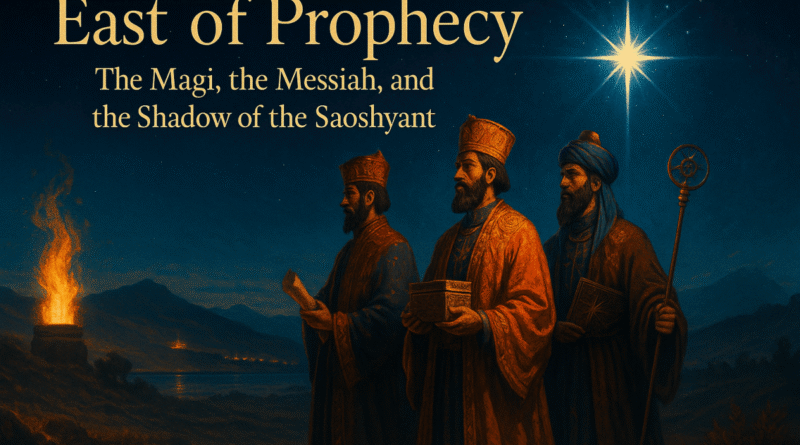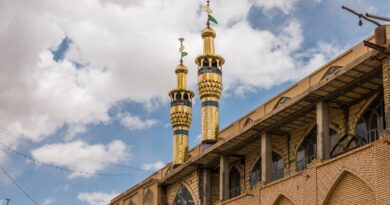The Zoroastrian Prophecy of Saoshyant in Matthew’s Gospel
Among the most iconic images of the nativity is that of three wise men kneeling before the infant Jesus, offering gold, frankincense, and myrrh. But this narrative appears in only one place in the New Testament: the Gospel of Matthew. And Matthew never says they were three, nor does he call them kings. He simply refers to them as magi—a term with far more historical and theological weight than most realize.
Matthew 2:1–2 – The Magi Arrive in Jerusalem
1 Now after Jesus was born in Bethlehem of Judea in the days of Herod the king, behold, wise men from the East came to Jerusalem,
2 saying, “Where is he who has been born king of the Jews? For we saw his star when it rose and have come to pay homage to him.”
3 When Herod the king heard this, he was troubled, and all Jerusalem with him;
4 and assembling all the chief priests and scribes of the people, he inquired of them where the Messiah was to be born.
5 They told him, “In Bethlehem of Judea, for so it is written by the prophet:
6 ‘And you, O Bethlehem, in the land of Judah, are by no means least among the rulers of Judah; for from you shall come a ruler who will shepherd my people Israel.’”
7 Then Herod summoned the wise men secretly and ascertained from them what time the star had appeared.
8 And he sent them to Bethlehem, saying, “Go and search diligently for the child, and when you have found him, bring me word, that I too may come and pay homage to him.”
9 After listening to the king, they went on their way. And behold, the star that they had seen when it rose went before them until it came to rest over the place where the child was.
10 When they saw the starthey rejoiced exceedingly with great joy.
11 And going into the house, they saw the child with Mary his mother, and they fell down and paid homage to him. Then, opening their treasures, they offered him gifts: gold and frankincense and myrrh.
12 And being warned in a dream not to return to Herod, they departed to their own country by another way.
So, who were these mysterious visitors “from the East”? And why does Matthew, alone among the Gospel, include them?
What often goes unnoticed is that the magi were not merely exotic travelers or generic stargazers. The word do is rooted in the priestly class of ancient Persia—Zoroastrian sages. These were not just foreigners. They were heirs to an eschatological tradition centered on cosmic struggle, final judgment, and the promise of a divinely sent savior: the Saoshyant.
This article explores the possibility that Matthew’s inclusion of the magi was not merely a decorative detail but utilized to make a deliberate theological statement—signaling that the birth of Jesus was not only the fulfillment of Jewish prophecy, but also a response to the ancient Zoroastrian hope for a world-renewing savior.
The Gospel of Matthew and the Obsession with Fulfilled Prophecy
Of the four Gospel writers, Matthew is the most overtly concerned with showing Jesus as the fulfillment of ancient prophecy. Again and again, his narrative pauses to point out how specific events occurred “to fulfill what was spoken by the prophet.” No other Gospel writer comes close to this level of emphasis.
From the opening chapters, this pattern is unmistakable:
- Jesus is born of a virgin: “All this took place to fulfill what the Lord had spoken by the prophet: ‘Behold, the virgin shall conceive and bear a son…’” (Matthew 1:22–23, citing Isaiah 7:14)
- He is born in Bethlehem: “For so it is written by the prophet…” (2:5–6, citing Micah 5:2)
- The flight to Egypt: “This was to fulfill what the Lord had spoken by the prophet, ‘Out of Egypt I called my son.’” (2:15, citing Hosea 11:1)
- Herod’s massacre of infants: “Then was fulfilled what was spoken by the prophet Jeremiah…” (2:17–18)
- Jesus settling in Nazareth: “So that what was spoken by the prophets might be fulfilled, that he would be called a Nazarene.” (2:23)
This isn’t subtle. Matthew is building a case, verse by verse, that the life of Jesus was not a random sequence of events, but the precise unfolding of divine script—foretold centuries earlier.
Within that context, the story of the magi is not just a charming anecdote. It’s another calculated piece in Matthew’s theological architecture. But unlike the previous prophecies explicitly linked to Jewish scripture, the magi seem to point elsewhere—to a different prophetic tradition, one not from Israel but from the East.
The Magi and Zoroastrianism
The word magi (Greek: do) carries far more theological and historical significance than its later associations with mystics or fortune tellers might suggest. In the ancient world, it referred to a priestly caste within the Median and Persian empires—figures deeply embedded in the religious life of the East. These were not generic philosophers or astronomers; they were Zoroastrian priests, trained in ritual purity, fire worship, and the reading of celestial signs. Their presence in Matthew’s nativity account is not incidental. It reflects a deliberate nod to a parallel prophetic tradition, one that had long anticipated the appearance of a divinely appointed savior.
Zoroastrianism, founded by the prophet Zarathustra (Zoroaster) between 1000 and 600 BCE, is one of the oldest surviving monotheistic religions. At its center is the worship of Ahura Mazda, the Wise Lord, creator of all things good. Zarathustra rejected the polytheistic and ritualistic religions of his day and presented a stark ethical dualism: the world is defined by a cosmic struggle between asha (truth, order, righteousness) and druj (falsehood, chaos, deception). Humanity is not a passive observer in this conflict; every person is a moral agent, responsible for aligning themselves with truth through good thoughts, good words, and good deeds.
Unlike cyclical worldviews common in many ancient religions, Zoroastrianism presents a linear understanding of history, moving toward a final judgment and the ultimate defeat of evil. At death, each soul is judged at the Chinvat Bridge. The righteous cross safely into the House of Song; the wicked fall into the House of Lies. But this individual judgment is only the beginning. At the end of time, all souls will rise in bodily resurrection and face a final reckoning. The world itself will be purified through a river of molten metal, which will cleanse the righteous and burn away evil. Judgment, in Zoroastrian theology, is not eternal damnation—it is a refining fire, a necessary step in the restoration of creation.
This moral and eschatological framework sets the stage for one of Zoroastrianism’s most profound expectations: the coming of a final savior who will bring about the renewal of the world.
The Saoshyant and the Promise of World Renewal
Zoroastrian eschatology reaches its climax in the figure of the Saoshyant—literally, “the one who brings benefit.” He is the long-awaited savior who will appear at the end of history to defeat falsehood, raise the dead, and usher in the Frashokereti, or the final renovation of the world. This is not an abstract concept—it is the culmination of Zoroaster’s theological vision.
According to tradition, the Saoshyant will be born of a virgin, miraculously conceived from the preserved seed of Zoroaster, which lies hidden in the waters of a sacred lake. In the appointed time, a pure maiden will bathe in that lake and conceive by divine will. The child she bears will be sinless, righteous, and uniquely empowered to complete the cosmic struggle. His arrival will be marked by a great celestial sign—a radiant star or heavenly light—that heralds the end of the age and the dawn of final judgment.
Once he appears, the Saoshyant will lead humanity through the climactic events of Frashokereti. The dead will rise, their souls reunited with their bodies. The entire world will undergo purification through a river of molten metal—experienced by the righteous as warmth and by the wicked as cleansing pain. But even the suffering of the wicked is not eternal torment; it is the removal of evil’s last residue. At the end of this process, Angra Mainyu, the destructive spirit, is annihilated. Time itself ceases. The universe is reborn—incorruptible, eternal, and wholly good.
A Convergence of Prophecies: Jesus and the Shadow of the Saoshyant
In light of this, the magi’s presence at the birth of Jesus in the Gospel of Matthew begins to resonate with deeper significance. These were not mere foreign dignitaries or wandering astrologers. They were priests of a theological system that had long awaited a virgin-born savior, heralded by a celestial sign, who would usher in the final purification and renewal of the world. In their journey westward, guided by a star, and in their act of bowing before the infant Jesus, we see more than reverence—we see recognition. The symbols are aligned. The pattern is familiar. The arrival of Jesus matches the shape of their own eschatological hope.
Matthew, without saying it directly, invites the reader to draw the connection. He never names Jesus as the Saoshyant, just as he never explicitly identifies the magi as Zoroastrian. But the parallels are unmistakable. A miraculous birth. A cosmic sign. The arrival of a figure who will speak truth, judge the world, and restore creation. The Gospel that is so concerned with fulfilled prophecy within the Jewish tradition opens its second chapter with an event that seems to fulfill prophecy from outside it. In doing so, Matthew broadens the horizon of messianic expectation. The birth of Jesus is not merely the climax of Israel’s story—it is also meant as the answer to a universal longing, one that reached even into the heart of Persia, where priests of an ancient monotheism watched the skies and waited for a king.
Conclusion: From East to Bethlehem
The inclusion of the magi in Matthew’s nativity story is not a literary flourish or decorative aside—it is a deliberate theological signal. It gestures outward, beyond the borders of Israel, to a wider prophetic tradition that had long anticipated the arrival of a world-renewing savior. By showing Zoroastrian priests bowing before Jesus, Matthew subtly affirms that the Messiah born in Bethlehem was not just the fulfillment of Jewish prophecy—but the answer to a hope embedded deep within the conscience of another ancient faith.
In the magi’s recognition of Jesus, we see a convergence of two eschatologies: Israel’s longing for the Messiah and Persia’s expectation of the Saoshyant. The parallels are too precise to ignore. What Matthew quietly proposes is profound: that the child born in the manger is the one both traditions were waiting for.
Parallels Between the Saoshyant and Jesus in Matthew’s Gospel
| Zoroastrian Belief | Matthew’s Account of Jesus |
|---|---|
| Virgin birth of the Saoshyant | Jesus is born of the virgin Mary (Matt. 1:22–23) |
| Star or celestial sign heralds his coming | A star guides the magi to Jesus (Matt. 2:1–10) |
| Savior brings final judgment and renewal | Jesus is portrayed as judge and restorer (Matt. 3:12, 25:31–46) |
| Priestly class (magi) await his arrival | Magi travel from the East to worship Jesus (Matt. 2:1–2) |
| World ends in purification and resurrection | Jesus promises renewal and resurrection (Matt. 19:28, 22:31) |
| Saoshyant leads Frashokereti (world renewal) | Jesus ushers in the Kingdom of Heaven |




